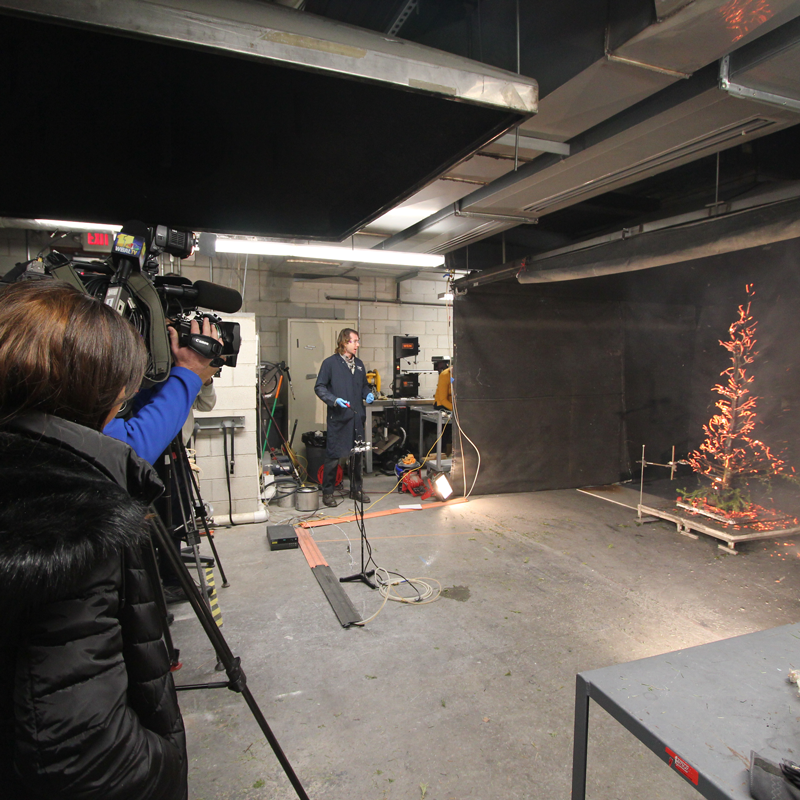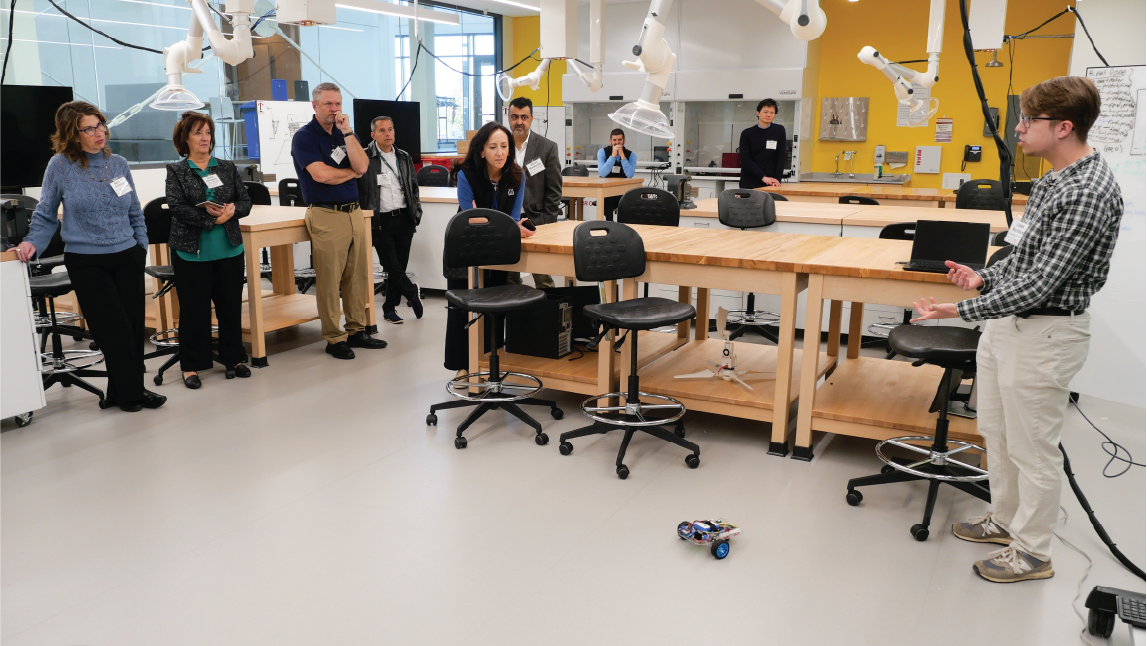News Story
In the News: Maryland Engineers Advance Holiday Safety, Fire Data Research

Dr. Isaac Leventon with media attending the 2022 event.
Each year, approximately 25 to 30 million natural Christmas trees are sold in the United States. While this symbol of the season brings an air of festivity to homes during the holidays, it is also responsible for approximately 160 house fires each year according to statistics from the National Fire Protection Association (NFPA).
To increase public safety awareness about Christmas trees, the University of Maryland Department of Fire Protection Engineering hosts an annual Christmas Tree Burn Demonstration.
Now in its ninth year, the event—which is open to the media—features live demonstrations highlighting the potential hazards of this holiday fixture, and in particular, the differences between what happens to a dry versus well-watered tree when exposed to a potential ignition source.
"A dryer tree has the potential to support easier ignition, faster fire growth, and larger peak fire size," explained Isaac Leventon.
Leventon, a researcher with the Fire Research Division at the National Institute of Standards and Technology (NIST), and both a UMD alumnus and adjunct lecturer with department, has managed the event for almost a decade in an effort to increase public awareness, "It's not that we have thousands of these fires every year, but the reported fire statistics indicate that they are particularly dangerous when they do occur."
Leventon refers to NFPA reported data collected between 2011 and 2015, which found that when Christmas trees were the first item ignited in home structure fires, one out of every 32 reported fire events resulted in a death.
In addition to providing an important safety message, measurements are recorded during these fire demos. Metrics like fire growth rate, peak burning rate, and burning duration are all collected to help quantify the observed burning behavior.
Data collected by Leventon and his colleagues over the years has contributed to the growing body of research in better understanding firebrand behavior. Understanding firebrands—smoldering or flaming particles that can be carried through the air and cause the ignition, burning, and subsequent fire spread over vegetation or structures away from the original front of a wildfire— is critical to better understanding wildfire behavior and spread.
“Each year we’ve collected burn rate data, and that growing repository of data helps us better understand how factors such as tree species, moisture content, and ignition conditions affect burning behavior,” explained Leventon.
"Our demonstrations are not intended to spark fear about trees in homes,” said Leventon. “We want to ensure that people celebrate the holidays safely, and that if you plan on keeping a natural Christmas tree this season, keep it healthy, well-watered, and away from potential ignition sources."
“In 2019, we were able to burn a larger number of trees with expanded instrumentation which enabled us to better quantify the total yield of firebrands produced by burning vegetation (a key input for physics-based modeling of wildfires)," said Leventon. "This analysis provided the first ever direct measurements of firebrand yield of large scale vegetative fuels and how that varies with tree species and moisture content.”
The demonstration also sets the stage for some collegial competition. Fire engineering students and researchers from around the world are invited to test their knowledge and predict the burn rate for one of the trees as part of the event’s “Tree Burn Competition”—vying for top spots and the coveted Gold and Silver Pinecone Awards.
Leventon added the competition to encourage communication and collaboration between members of the fire safety science community. This year’s event drew about 150 participants from across 20 countries and nine U.S. states.
While supporting research and education, public safety awareness is still the event’s number one goal.
“Our demonstrations are not intended to spark fear about trees in homes,” said Leventon. “We want to ensure that people celebrate the holidays safely, and that if you plan on keeping a natural Christmas tree this season, keep it healthy, well-watered, and away from potential ignition sources.”
For more Christmas tree safety tips, visit the National Fire Protection Association’s Winter Holiday Safety site.
Fire Protection Engineering’s 2022 Christmas Tree Burn Demonstration in the News
Avoiding a Christmas crisis: Maryland engineers offer tips to keep your tree safe (WBAL11)
Why UMD Burns Christmas Trees to Make Your Holiday Safer (NBC4)
How fast can an unwatered Christmas tree go up in flames? (WTOP)
Published December 15, 2022






